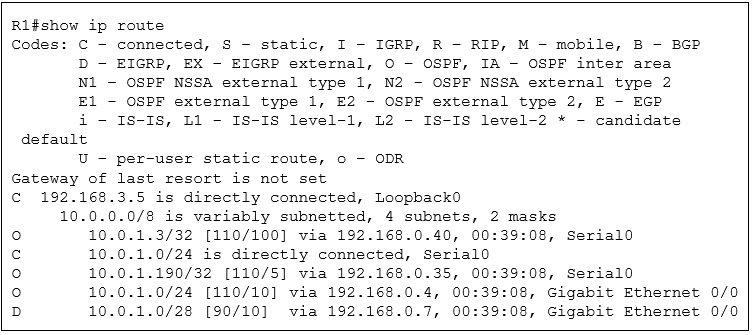
Refer to the exhibit. Traffic sourced from the loopback0 interface is trying to connect via ssh to the host at 10.0.1.15. What is the next hop to the destination address?

Refer to the exhibit. Traffic sourced from the loopback0 interface is trying to connect via ssh to the host at 10.0.1.15. What is the next hop to the destination address?
The routing table shows various entries, but the router will use the entry with the longest prefix match that includes the destination IP address 10.0.1.15. The subnet 10.0.1.0/28 considered in option A has a range of 10.0.1.0 to 10.0.1.15. However, 10.0.1.15 is the broadcast address for that particular subnet and is not a valid host address. The correct matching entry for a host address that could be used for SSH is the one with a /24 prefix: 10.0.1.0/24 via 192.168.0.4. Therefore, the next hop to the destination address is 192.168.0.4.
Answer A is incorrect. If select 10.0.1.0/28 and subnet mask is 255.255.255.240. Then, host address range will be 10.10.1.1 to 10.10.1.14. Therefore, it coorrect answer should be B.
Well, in the question is not mentioned that the IP is a host, so then you can have .15 as the broadcast IP valid.
Sorry I didnt see the word "host", you are rite, it would not be a valid IP for host. So then the rite answer is B
Well, what if its sending a broadcast? 10.0.1.15 still belongs to 10.0.1.0/28 subnet. Answer: A
Forget the comment above. The question states that is trying to connect to a host via SSH... Sorry!!
Because I think .15 is the broadcast for the /28 network and here its via SSH.. is that what you mean is wrong?
routing protocol does not take into consideration what the services / end user trying to do, hence SSH means nothing to routing protocol. routing protocol just take the IP address and first match with the longest prefix, hence to answer a routing protocol question, 10.0.1.15 does fall into 10.0.1.0/28 route in the routing table.
I think even answer B is incorrect. As there is another route in the table stating that 10.0.1.0/24 network is directly connected on Serial0. And if I understand the previous entry conrrectly, Serial0 interface has 192.168.0.40. (Probably) Answer C
C is 192.168.0.40 - 10.0.1.3/32 via 192.168.0.40. That is not the host, you are looking for 10.0.1.15.
Things like network or broadcast address have nothing to do with routing, if the address u try to access is in the subnet it will route it, no questions asked.
why doesn't it use the directly connected route??
Yes, if people not think the answer is A (192.168.0.7). With same prefix, the next hop should be chosen directly connected with AD=0.
Agreed. It should be Serial0 IP and none of the options listed is for Serial0.
There is no such an answer.
routing protocol does not take into consideration what the services / end user trying to do, hence SSH means nothing to routing protocol. routing protocol just take the IP address and first match with the longest prefix, hence to answer a routing protocol question, 10.0.1.15 does fall into 10.0.1.0/28 route in the routing table.
Spoke to a couple of guys and dug it up a bit, B is the correct answer, A is incorrect because router wouldn't use 10.0.1.0/28 subnet route, since the destination IP (10.0.1.15) would be a broadcast address for this subnet, so because the question states: "trying to connect via ssh" it can't be used
its B ...
Tricky question, if you select A 10.0.1.0/28 you're going to "fall" into a broadcast address
A is incorrect because using /28 SM 10.0.1.15 will be the broadcast address, we need a usable IP B is inclusive of the destination address and correct C is incorrect, it's a host route that leads only to the host with IP 10.0.1.3 D being used as the next hop isn't even in the routing table
B is the correct answer
Sneaky!!
it´s B It should be Serial0 because of the double /24s, the connected one has lower AD. But Serial0 isn´t listed in the options, so we have only B as a choice.
Answer is B.
Correct In this network 10.0.1.0/28 the address 10.0.1.27 will be considered broadcast
Sorry, the ip brodcast is 10.0.1.15, not 10.0.1.27
Both entries have the same administrative distance (10), but the first entry (O) has a longer prefix length (/24) compared to the second entry (D) with a shorter prefix length (/28). Since the destination IP address (10.0.1.15) falls within the range of the longer prefix (10.0.1.0/24), the first entry will be used. Therefore, the next hop to the destination address 10.0.1.15 is: A. 192.168.0.4
The routing process doesn't know ssh or anything about the host or broadcast. 10.0.1.15 goes to 10.0.1.0/28. But the ssh command won't work.
A is a broadcast address, not a host. Thus the answer is B
B is the correct answer
the longest prefix /24 no /28 because it will give 14 hosts and the 10.10.1.15 is the broadcast while /24 give you 30 hosts the 10.0.1.15 is inclusive